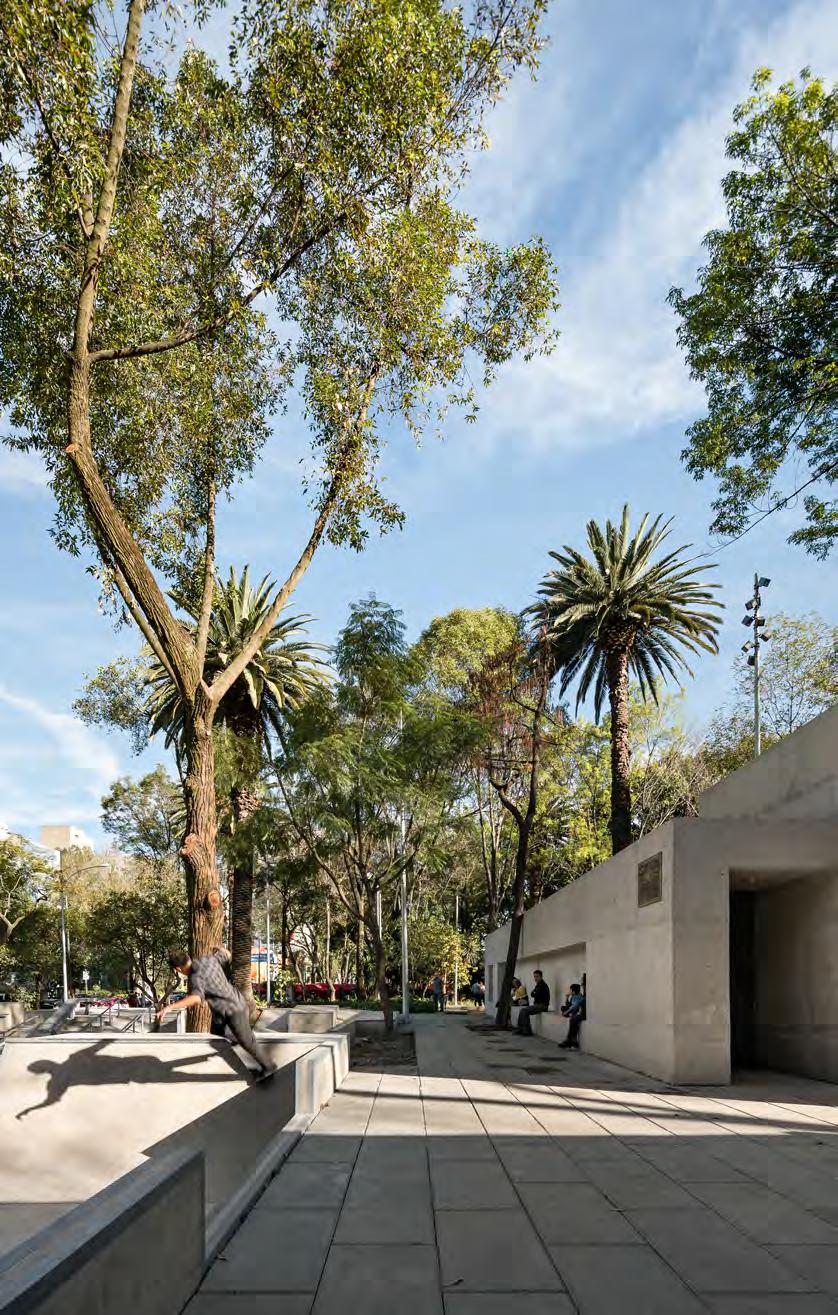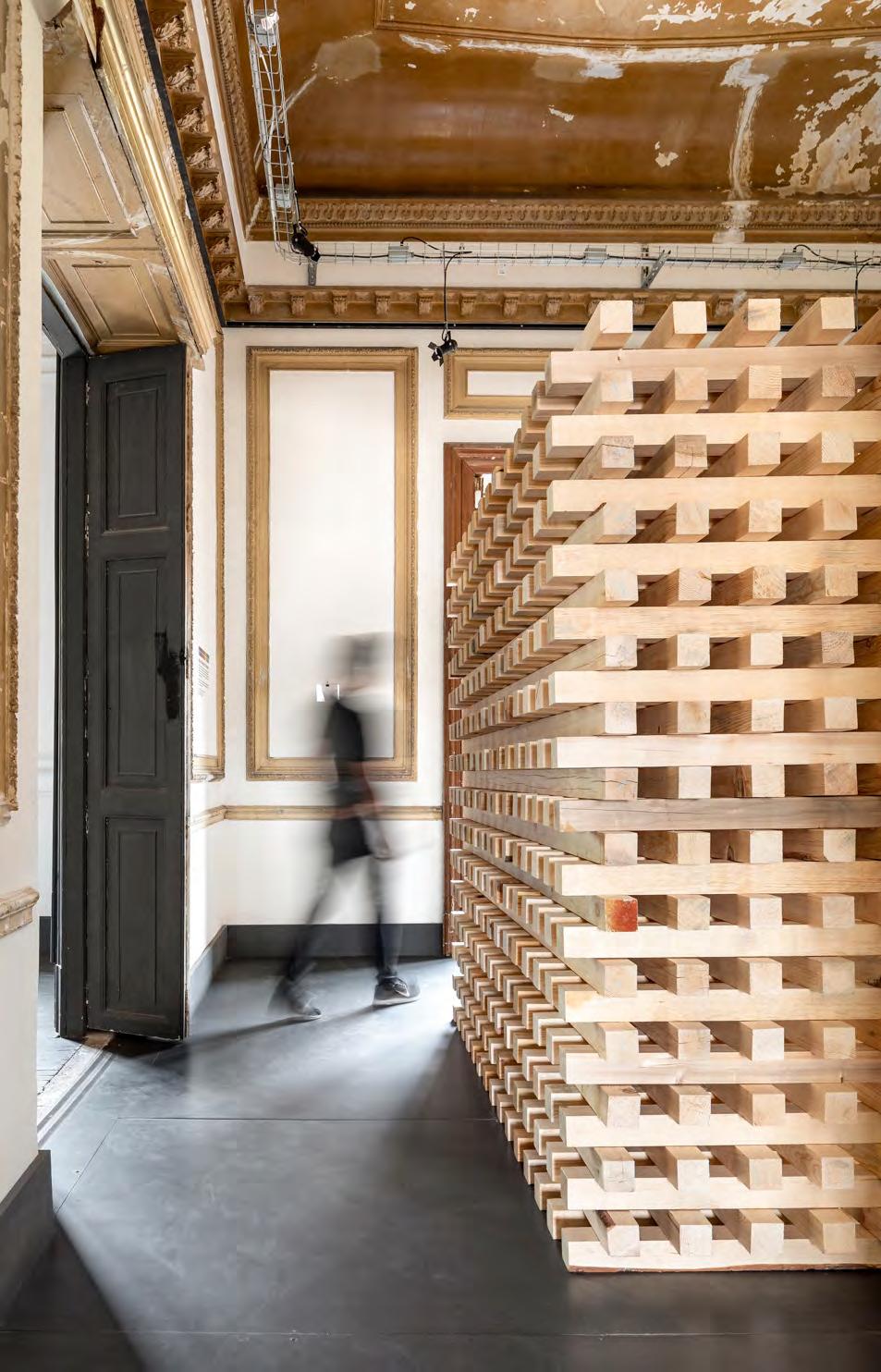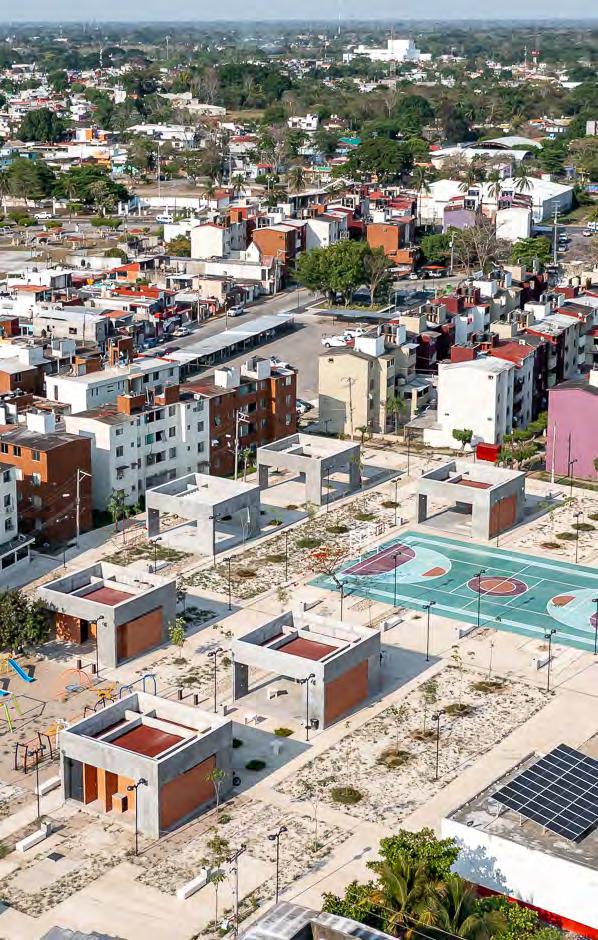






Eréndira Tranquilino holds a master’s degree in Urban Design from the John H. Daniels Faculty of Architecture, Landscape, and Design at the University of Toronto.
She is a licensed architect from Mexico, holding a five-year bachelor’s degree in Architecture from UNAM, National Autonomous University of Mexico.
Erendira worked at Estudio MMX, a recognized architecture and urban design studio, where she acquired extensive experience.
In 2016, Eréndira established a small architecture studio.
This document shows a selection of projects on which she collaborated, some of which she designed at her professional experience and her urban design master projects.







Installation Donceles Galeria Panteon, Mexico City, 2018
Designer:
Constructor:
Photography: Dane alonso
Description:
In 2018, a small wooden facility was designed and built in just two days and with a small budget. The gallery where the project was located was a small room in an ancient house on Donceles Street in the historic center of Mexico City.
The installation consists of a volume based on wooden lumbers with a square geometry on the outside and cylindrical inside (the lumbers are 7”x 7” pieces of pressure wood used for on-site construction. ). The lumbers are placed with a separation of 7” (same width as the piece) and arranged perpendicularly on each level, generating air between the pieces and a structure that works with simple gravity.



Description:
Designer: Eréndira Tranquilino and Mariel Collard
Constructor: Isaias Estrada
The land where the project is located is in Amatlán de Quetzalcóatl, a community near Tepoztlán defined by its dramatic topography due to the proximity to the massifs of volcanic origin characteristic in this area.
The house is designed as a space for rest where the views to the lower valley have been prioritized. The program is developed on a single storey broken to adapt to the topography through cut and fill operations. Each volume corresponds to a part of the program and is divided into 3 construction stages, which will be built as the family grows.



Parque Infonavit, PMU SEDATU Cardenas, Tabasco, 2020
Designer: Eréndira Tranquilino in collaboration with Alejandro Quintanilla
Team: Omar Granados y Viridiana Hernandez
Constructor: Jorge Levi
Photography: Onnis Luque
Description:
As part of the Urban Improvement Program through SEDATU (The Secretariat of Agrarian, Territorial and Urban Development), highly marginalized areas are intervened with through architectural projects to improve the quality of life of their inhabitants.
The project is based on a single apparent concrete construction module that functions as the main structure. Depending on their use, it is flexible to certain variations through interior partition walls, platforms at different levels, and roof openings. The same module has the following variations in the project: an open forum, games area, cafeteria, and area for diners and services. These modules are located throughout the park, between planters, a children’s play area, small squares and a multipurpose field.
The project was a finalist by UN-Habitat and UIA (International Union of Architects) for the UIA 2030 Award.It was nominated for work of the year by Archdaily and won a Silver Medal at the XVI Biennial of Tabasqueña Architecture for the Urban Regeneration category in 2023.










Mexicali´s House Mexicali, Baja California, 2021
Designer: Erendira Tranquilino, Mariel Collard
Description:
Mexicali is situated in a desert environment with summers that exceed 40°C (104°F). That’s why, when designing and building in this context, orientation and material selection become crucial for creating comfortable spaces and an energy-efficient home. These decisions guided the design of this exposed brick house for a family of three.
For instance, the “ventilated attic” allows for the natural ventilation of the hot air that accumulates between the ceilings and the roof of the house; the “cactus wall” features protruding bricks on the facades to cast shadows on the walls with greater solar exposure; and the “chimney effect” facilitates the release of hot air through the highest openings in the house.







MUD_ Reshaping the City: Sheppard Avenue, 2022
Description:
Through an investigation into the unfavorable avenues of the city concerning pedestrians, an intervention was proposed on Sheppard Avenue, where the avenue was reconfigured in terms of scale, green areas, mixed-use and housing, among others. In conjunction with this proposal, strategies were suggested to intervene and enhance West Highland Creek.



Description:
The main intention was to generate an achromatic environment of stone materials. The resulting space is a neutral canvas that prioritizes the textures and colours of the products on display.
The primary material is marble. On the façade, it is used in large-format pieces where the natural veins of the stone stand out. Using a single material in the envelope makes the volume perceived as a monolith that, in contrast, emphasizes the perforations of the sideboards and the JET logo.
The furniture is the setting for the exhibition of each piece. The idea of the excavated stone block continues inside the store with the main furniture, whose niches and openings refer to hand-carving a mineral. This heavy and timeless piece seems to emerge from the earth.
The steel elements with simple profiles and right angles complement the furniture on shelves and interlocking hanging tubes. The steel – in addition to reflecting the products – aligns with the grayscale of the stone, the polished apparent concrete on the floors and the flattening of the walls.

Orchid Pavilion (as part of Casa Wabi´s architecture competition)
Casa Wabi, Oaxaca, 2021
Designer: Erendira Tranquilino in collaboration with Mariel Collard and Hector Lopez
Description:
Casa Wabi’s Orchid Pavilion and Garden is an exterior laboratory to work and learn with orchids and their habitats. Most orchids are epiphytes, meaning they use an external physical support (commonly a tree) to grow. They do not obtain their moisture and nutrients from soil or the host, but rather from air and rain. We take orchids’ epiphytic lifestyle as a spatial queue to design a pavilion where the structure itself creates an environment for the plants’ aerial growth. Nestled among the local vegetation of the tropical dry forest ecosystem, this project gives room for the encounter of humans and plants.
The pavilion intervenes minimally on the ground and is mostly made of local, unprocessed, and sustainably harvested tropical hardwood and palm tree products. A simple foundation is made with isolated concrete footings which serve as the base for the elevated light timber structure. The assembly and materials emphasize the permeability and indirect light sought by orchids in their natural habitats


Minatitlan´s Pier. PMU SEDATU Minatitlán, Veracruz, 2021
Designer: Eréndira Tranquilino and Mariel Collard in collaboration with Alejandro Quintanilla Team: Omar Granados, Viridiana Hernandez
Description:
As part of the Urban Improvement Program through SEDATU (The Ministry of Agrarian, Territorial and Urban Development), highly marginalized areas are intervened through architectural projects to improve their inhabitants’ quality of life.

The project proposes a 2.7km long continuous walkway parallel to the Coatzacoalcos River. The route is articulated by a series of specific interventions that generate living spaces, routes that bring the visitor closer to the river and promote physical and recreational activities. In general, the project seeks to revalue and revitalize the characteristic wetland ecosystems of this territory and their importance in riverine ecology.
The project areas are called:
A- Umbral
B- Humedal de Tributario
C- La Punta
D- Accesos a Río
E- Humedal de Río
F- Estación









MUD_ ATLAS, 2023
Designer: Eréndira Tranquilino, Mahima Patel and Akshaya Shankar Advisor : Simon Rabyniuk
Description:
Through an Atlas, we worked on an overlay map exercise to understand the different elements related to the Housing Crisis in Toronto. The document was divided into chapters related to the density of the different policies and guidelines related to Housing in the City.
Income, Transport, Policies, Guidelines and Natural Elements were the main layers from where we studied one of the biggest problems for the City.

Exhibition in GSD_Kirkland Gallery Exhibited piece: Line Cambridge Massachusetts, U.S.A. 2019
Designer: Erendira Tranquilino Exhibition: A quien corresponda 2019
Gallery: Kirkland Gallery at the GSD Kirkland Gallery at Harvard University.
Description:
Line as: definition of a volume projection depth limit origin




Description:
Garden of Art Pavilion San Rafael neighborhood, Mexico City, 2017
Designer: Eréndira Tranquilino in collaboration with R-Zero Team: Oscar Díaz, Omar Granados and Cesar Castillo
Constructor: Gursa SA de CV
Photography: Dane alonso
In 2017, the R-Zero architecture office was in charge of developing the project for the plaza to the monument to the Mother on Sullivan and Reforma streets in the center of Mexico City. That same year, we were invited to design the Art Garden Pavilion. Located behind the mother monument is the Art Garden. This garden is used on weekends by painters, sculptors, engravers, photographers, etc., who exhibit and sell their paintings outdoors, a tradition since 1955.
The project consists of 3 offset volumes of different heights, with a skatepark in front. The first volume contains public services, the second has two levels for the park’s management team, and the third includes an interior ramp to the artists’ warehouse and a bench outside that functions as the skatepark. The government carried out the project, and due to budget issues, the original project was altered by eliminating one level and modifying all the windows.


Description:
The project is located at the entrance of the Magdalena River to Mexico City. According to water quality studies, it was found that there is a section of the river where it is contaminated. In the absence of infrastructure on the part of the city, there are self-built homes, which, lacking a drainage system, connect their waste pipes to the river. Likewise, they lack public spaces to exercise, and their relationship to the river is zero.
Through remediation with natural technologies of the Magdalena River, access to the green spaces adjacent to the water is sought to generate public spaces for coexistence, connection and recreation. And thus generate a healthier relationship between the community and nature.














Plazas Nayarit- SEDATU
Designer: Estudio MMX
Team: Erendira Tranquilino
Photography: Daniel Alonso
Description:
In 2018, Hurricane Willa destroyed much of the infrastructure of the municipalities of Tecuala and Agua Verde in the state of Nayarit. In 2019, in collaboration with Estudio MMX, two public squares and a sports park were designed and built.
In Tecuala, the project assigned was La Plaza a la Madre. In Agua Verde, the projects assigned were the church plaza and a sports car.
The projects and their program were designed through public consultations with the surrounding communities. The red partition was used for slopes and flooring as a construction material so the inhabitants could participate in the construction since it is a local construction method. In the three projects, the partition slope was used to generate a habitable topography, delimit spaces, exalt a sculpture, and provide stands.






Description:
Today, more than two thirds of the waterfront is restricted to public access and its identity belongs more to the passenger’s port than it would to the active core of Helsinki’s city centre.
Acknowledging these issues, forces us to take action into reclaiming the waterfront as an active open space. The city centre facade to the sea should be an extension of the public realm, where people can have the best of both the urban and the marine environment, a place where the port activities do not overshadow the public realm, but on the contrary, strengthen the character of the site as a dynamic urban space. Hence, the proposal creates a new framework that consolidates the urban frontages of the surrounding districts and brings back the public character of the waterfront to the citizens.



Water and Mexico City 2024
Description:
Mexico City is the most populous city in North America and one of the most important cultural centers in the world.
Today, this territory faces one of the worst water crises in history.
What few know is that the area where around 25 million people live was once a lake. However, its citizens are unaware that this vital liquid is running out, their responsibility and how its hydraulic system works.
My thesis project seeks to document and advocate to make this water crisis and its causes and effects visible through an Atlas and readable media.
The project is divided into three parts:
The history of the lake and how it was dried
The water system today and what strategies can be applied to conserve water
What are the different scenarios for Water in The City
I believe that education leads to awareness, and this leads to change.
The website for the research project: https://aguacdmx.com/
+1 437-436-3942
eren.arq @ gmail.com
https://www.linkedin.com/in/erendiratranquilino/ THANK YOU
https://www.instagram.com/collard_tranquilino/



